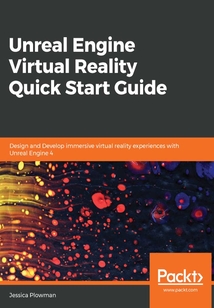首頁 > 計(jì)算機(jī)網(wǎng)絡(luò) >
數(shù)據(jù)庫
> Unreal Engine Virtual Reality Quick Start Guide最新章節(jié)目錄
舉報(bào) 

會員
Unreal Engine Virtual Reality Quick Start Guide
Withtheabilitytoputplayersdirectlyinthegame,virtualrealitygivesusersthechancetoexperiencedigitalworldsdirectly.Nevertheless,manydesignersareunsurewheretostartwhenworkingwiththisamazingtechnology.Withthisbook,youwilllearnuserexperiencedesignprocessesandcreateimmersivegameplayexperiencesdesignedforentertainmentandplayercomfort.UsingthepowerofUnrealEngine4’sBlueprintvisualscriptinglanguage,youwillbuildplayerinteractionandlocomotionsystemsfromscratchandusetheseflexiblesystemstocreateasamplegame,aswellasdevelopfunctional2Dand3Duserinterfacesforplayerstointeractwith.Andalsolearnthebestpracticesforcreatinggameartforvirtualreality.Finally,youwilllearnhowtotestyourapplicationwithyourtargetaudienceandfinalizeyourgamefordistribution.Bytheendofthisbook,youwillhavetheknowledgetobeabletomaketheleapfromtraditionalgamedevelopmenttocreatingimmersivevirtualrealityexperiencesusingUnrealEngine4.
目錄(100章)
倒序
- coverpage
- Title Page
- Copyright and Credits
- Unreal Engine Virtual Reality Quick Start Guide
- Dedication
- About Packt
- Why subscribe?
- Packt.com
- Contributors
- About the author
- About the reviewer
- Packt is searching for authors like you
- Preface
- Who this book is for
- What this book covers
- To get the most out of this book
- Download the example code files
- Download the color images
- Conventions used
- Get in touch
- Reviews
- Introducing VR Technology in Unreal Engine 4
- Why use Unreal Engine 4 for VR?
- What types of VR Technology are available to developers?
- Room-scale VR
- Seated VR
- Mobile VR
- Pros and cons of popular VR headsets
- HTC Vive
- Minimum hardware requirements
- Oculus Rift + Touch
- Minimum hardware requirements
- Windows Mixed Reality headset
- Minimum hardware requirements
- Samsung Gear VR
- Limitations of VR
- Introducing our sample project – Server 17
- Summary
- Locomotion Design and Starting Our Project
- The Human-Centered Design process
- Choosing our locomotion method
- Natural locomotion
- Artificial locomotion
- Cockpit locomotion
- Physical locomotion
- Setting up new game files in UE4
- Project setup
- Creating our custom Game Mode
- Creating a GameState
- Creating a custom PlayerPawn
- Programming our custom PlayerPawn
- Summary
- Exploring Riveting Gameplay in Virtual Reality
- What does VR bring to video games?
- Popular gameplay mechanics
- Shooter experiences
- Action/adventure experiences
- Vehicle experiences
- Physics-based experiences
- Puzzle experiences
- Rhythm experiences
- Educational experiences
- Designing the gameplay for Server 17
- Adding the hand functionality
- Building the teleportation
- The server – Building the puzzle box
- Building the first tool station
- Building the Timer
- Summary
- User Interface and User Experience inside VR
- What is UX design?
- User interfaces in VR
- Designing the UI elements for Server 17
- Displaying the level timer
- Redesigning the tool experience
- Summary
- Creating Optimized Game Art for VR in UE4
- Performance is key
- Artistic limitations in VR
- Static and skeletal mesh limitations
- Material limitations
- Lighting limitations
- Visual Effects (VFX) limitations
- Performance-boosting techniques
- Static and skeletal mesh techniques
- Material techniques
- Lighting techniques
- Visual effects techniques
- Measuring ingame performance
- Summary
- Finalizing Our VR Game and Next Steps
- The importance of game testing
- Collecting testing data
- Usability testing
- Card sorting
- Expert review
- Preparing for distribution
- Summary
- Other Books You May Enjoy
- Leave a review - let other readers know what you think 更新時(shí)間:2021-07-02 13:03:07
推薦閱讀
- 數(shù)據(jù)庫基礎(chǔ)教程(SQL Server平臺)
- Game Development with Swift
- 文本數(shù)據(jù)挖掘:基于R語言
- 大數(shù)據(jù)可視化
- Python醫(yī)學(xué)數(shù)據(jù)分析入門
- Ceph源碼分析
- 智能數(shù)據(jù)分析:入門、實(shí)戰(zhàn)與平臺構(gòu)建
- 信息學(xué)競賽寶典:數(shù)據(jù)結(jié)構(gòu)基礎(chǔ)
- INSTANT Android Fragmentation Management How-to
- 數(shù)據(jù)分析師養(yǎng)成寶典
- Visual Studio 2013 and .NET 4.5 Expert Cookbook
- Visual FoxPro數(shù)據(jù)庫技術(shù)基礎(chǔ)
- 大數(shù)據(jù)測試技術(shù):數(shù)據(jù)采集、分析與測試實(shí)踐(在線實(shí)驗(yàn)+在線自測)
- Oracle 內(nèi)核技術(shù)揭密
- Artificial Intelligence for Big Data
- Nagios Core Administrators Cookbook
- 機(jī)器視覺原理與案例詳解
- Foxtable數(shù)據(jù)庫應(yīng)用開發(fā)寶典
- 劍指大數(shù)據(jù):Flink實(shí)時(shí)數(shù)據(jù)倉庫項(xiàng)目實(shí)戰(zhàn)(電商版)
- SQL必知必會(第4版)
- 短文本數(shù)據(jù)理解
- Hands-On Deep Learning with R
- Spark大數(shù)據(jù)實(shí)時(shí)計(jì)算:基于Scala開發(fā)實(shí)戰(zhàn)
- Creating Concrete5 Themes
- IPFS原理與實(shí)踐
- AngularJS Essentials
- 大數(shù)據(jù)技術(shù)和應(yīng)用
- 涂抹Oracle:三思筆記之一步一步學(xué)Oracle
- 中小銀行運(yùn)維架構(gòu):解密與實(shí)戰(zhàn)
- 分布式數(shù)據(jù)庫:原理與實(shí)踐

